
Rosaceae, the rose family, is a family of flowering plants that includes 4,828 known species in 91 genera.
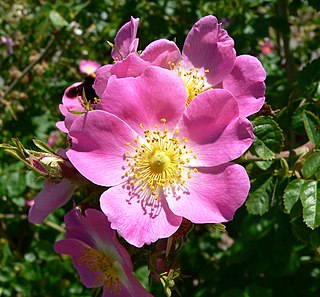
A rose is either a woody perennial flowering plant of the genus Rosa, in the family Rosaceae, or the flower it bears. There are over three hundred species and tens of thousands of cultivars. They form a group of plants that can be erect shrubs, climbing, or trailing, with stems that are often armed with sharp prickles. Their flowers vary in size and shape and are usually large and showy, in colours ranging from white through yellows and reds. Most species are native to Asia, with smaller numbers native to Europe, North America, and Northwest Africa. Species, cultivars and hybrids are all widely grown for their beauty and often are fragrant. Roses have acquired cultural significance in many societies. Rose plants range in size from compact, miniature roses to climbers that can reach seven meters in height. Different species hybridize easily, and this has been used in the development of the wide range of garden roses.

The rose subfamily Rosoideae consists of more than 850 species, including many shrubs, perennial herbs, and fruit plants such as strawberries and brambles. Only a few are annual herbs.

Rosa multiflora is a species of rose known commonly as multiflora rose, baby rose, Japanese rose, many-flowered rose, seven-sisters rose, Eijitsu rose and rambler rose. It is native to eastern Asia, in China, Japan, and Korea. It should not be confused with Rosa rugosa, which is also known as "Japanese rose", or with polyantha roses which are garden cultivars derived from hybrids of R. multiflora. It was introduced to North America, where it is regarded as an invasive species.
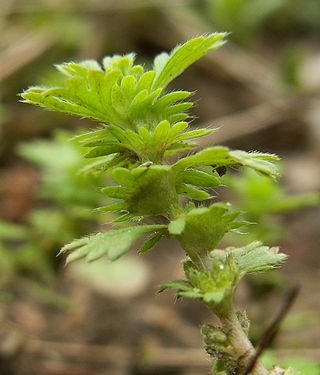
Aphanes (parsley-piert) is a genus of around 20 species in the rose family (Rosaceae), native to Europe, Asia and Australia. A 2003 study indicated that Aphanes may belong to the genus Alchemilla, commonly called lady's-mantle. They are slender, annual prostrate herbs, much-branched with deeply lobed leaves, pilose and on short petioles. The tiny green to yellow flowers without petals grow in clusters in the denticulate leaflike stipules.

Cercocarpus, commonly known as mountain mahogany, is a small genus of at least nine species of nitrogen-fixing flowering plants in the rose family, Rosaceae. They are native to the western United States and northern Mexico, where they grow in chaparral and semidesert habitats and climates, often at high altitudes. Several are found in the California chaparral and woodlands ecoregion.

Potentilla indica, known commonly as mock strawberry, Indian-strawberry, or snakeberry in North America, is a flowering plant in the family Rosaceae. It has ternate foliage and an aggregate accessory fruit, similar to the true strawberries of the Fragaria genus. Unlike the white or slightly pink flowers of true strawberries, Potentilla indica has yellow flowers, as do many other Potentilla species. It is native to eastern and southern Asia, but has been introduced to many other areas as a medicinal and an ornamental plant, subsequently naturalizing in many regions worldwide.

Purshia is a small genus of 5–8 species of flowering plants in the family Rosaceae which are native to western North America.

Rosa acicularis is a flowering plant in the Rosaceae family. It is commonly known as the prickly wild rose, prickly rose, bristly rose, wild rose or Arctic rose. It is a species of wild rose with a Holarctic distribution in northern regions of Asia, Europe, and North America.
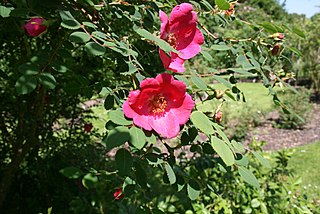
Rosa moyesii is a species of flowering plant in the rose family Rosaceae. It is native to western China. Growing to 4 m (13 ft) tall by 3 m (10 ft) wide, it is a vigorous deciduous shrub, with plentiful matte green leaves and flat red or pink flowers, with yellow central stamens, in summer. These are followed in autumn by prominent bottle-shaped rose-hips.

Rosa majalis is a species of deciduous shrubs in the genus Rosa, native to forests of Europe and Siberia. It grows to 2 m. and yields edible hip fruits rich in vitamin C, which are used in medicine and to produce rose hip syrup.
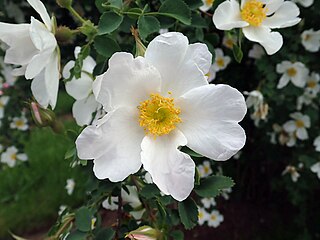
Rosa fedtschenkoana is a species in the plant genus Rosa in the family Rosaceae. Some authorities consider it a synonym of Rosa webbiana. It is native to the foothills of the Ala Tau, Tian Shan and Pamir-Alai mountain ranges in central Asia and northwest China. It is named after Olga Fédchenko, a Russian botanist. It is deciduous, forming a bushy and suckering shrub up to 2.5 metres high and as much across. The branches are covered in many prickles, many of which are fine and straight, but some are thicker and slightly hooked. The pinnate leaves are pale greyish green in colour and have usually between 7 and 9 leaflets. The flowers are white, up to 5 cm across, and are borne singly or in small clusters at the tips of the branches throughout the summer months. The flowers' scent has been described as being "like 'Hovis' [brown] bread with a little blackberry jam". The flowers are followed by small, pear-shaped, bristly orange-red fruits.

Malinae is the name for the apple subtribe in the rose family, Rosaceae. This name is required by the International Code of Nomenclature for algae, fungi, and plants, which came into force in 2011 for any group at the subtribe rank that includes the genus Malus but not either of the genera Rosa or Amygdalus. The group includes a number of plants bearing commercially important fruits, such as apples and pears, while others are cultivated as ornamentals.
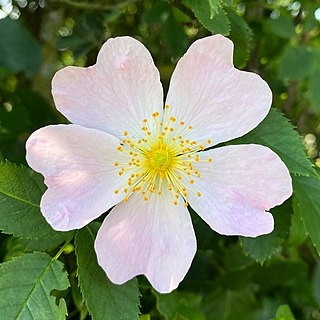
Rosa corymbifera, the thicket dog rose, is a species of flowering plant in the family Rosaceae. It is native to northwestern Africa, nearly all of Europe, the Caucasus, the Middle East, and Central Asia. It primarily differs from the dog rose Rosa canina in having downier leaves, particularly on the abaxial surfaces. The most widely used rootstock in Europe for garden roses is its cultivar 'Laxa'.

Rosa abyssinica is the only rose native to Africa. Europeans first learned of the rose in the writings of 19th-century Scottish botanist Robert Brown. Rosa abyssinica is included in the genus Rosa, and the family Rosaceae. No subspecies are listed in the Catalogue of Life.
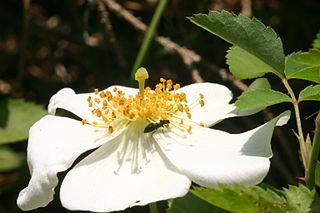
Rosa arvensis, the field rose, is a species of wild rose native to Western, Central and Southern Europe.

Rosa tomentosa, otherwise known as the harsh downy-rose, is a species of wild rose. It is a shrub growing to about 3 metres (10 ft). It is found in Asia Minor, the Caucasus, and much of Europe: the British Isles, France, Central Europe, northern Spain, Italy, and the Balkans . On the British Isles it can be found in hedgerows and woodland margins, and it typically flowers between June and July. Further south, in Bulgaria, it flowers in May.
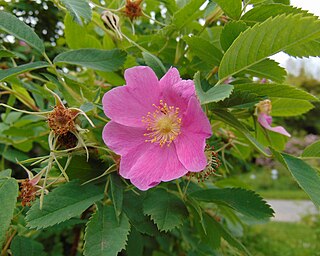
Rosa webbiana, occasionally called Webb's rose, wild rose, or thorny rose, is a widely distributed species of flowering plant in the family Rosaceae. It is native to Central Asia, Tibet and Xinjiang in China, Afghanistan, Pakistan, the western Himalayas, and Nepal. It grows in scrub, grassy places, valleys, and slopes. A diploid, its chromosome count is 2n = 2x = 14.
Rosa zaramagensis is a species of rose. Rosa zaramagensis is part of the genus Rosa, and the family Rosaceae Native to: North Caucasus, Transcaucasus.
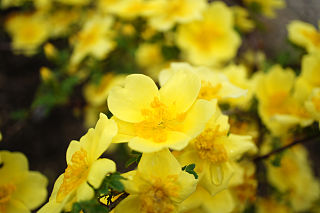
Rosa ecae is a species of flowering plant in the family Rosaceae, native to Central Asia, Afghanistan, Pakistan, and the western Himalayas. A shrub reaching 120 cm (4 ft), it is very similar to Rosa xanthina. It is a probable parent of the hybrids 'Golden Chersonese' and 'Helen Knight'.


















